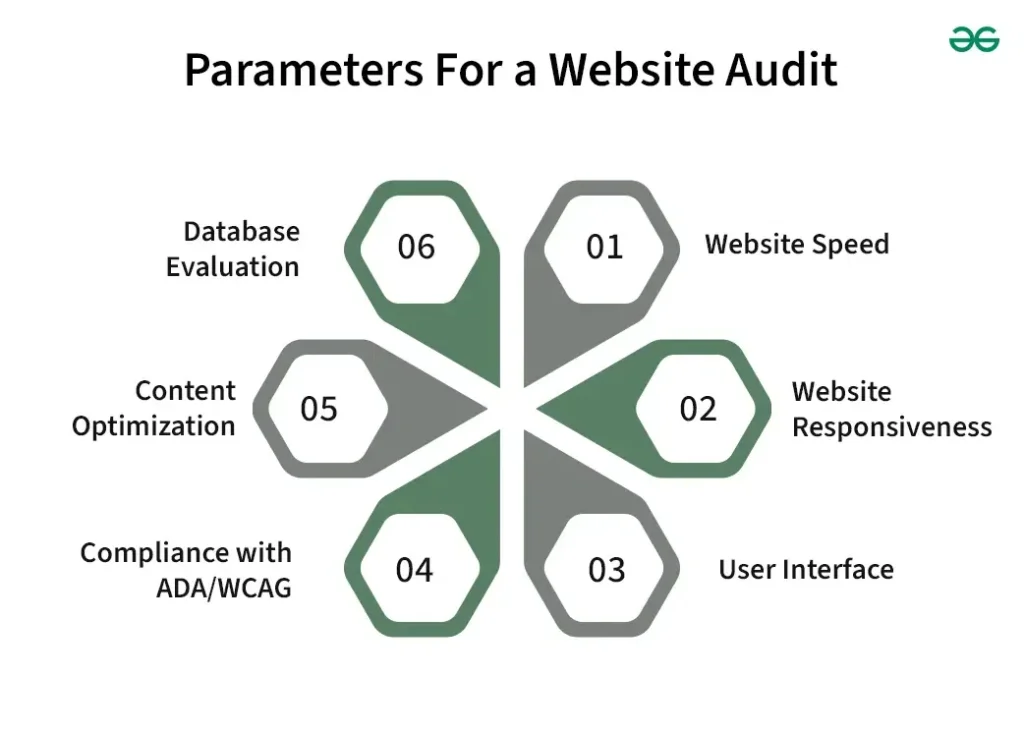Complete Website Audit: An Overview
A website audit is a comprehensive analysis of all factors that impact a website’s visibility, usability, performance, and search engine rankings. It helps identify issues and areas for improvement, ensuring that the site is optimized for search engines, delivers a good user experience (UX), and meets business goals.
Types of Website Audits
- SEO Audit
- Evaluates how well your site is optimized for search engines.
- Looks at on-page, off-page, and technical SEO factors to improve search rankings.
- Technical Audit
- Focuses on the technical aspects of the site, such as speed, mobile-friendliness, and crawlability.
- Ensures that the site is functional, secure, and accessible for both users and search engines.
- Content Audit
- Reviews the quality, relevance, and effectiveness of website content.
- Ensures that content is aligned with user needs and business goals.
- UX/UI Audit
- Evaluates the website’s design, usability, and overall user experience.
- Looks for issues that affect how users interact with the website, such as navigation, layout, and mobile responsiveness.
- Conversion Rate Optimization (CRO) Audit
- Analyzes how well the site converts visitors into leads or customers.
- Focuses on conversion paths, calls to action (CTAs), and user behavior.
- Security Audit
- Checks for vulnerabilities in the website’s security that could expose it to threats like hacking or data breaches.
- Ensures that the site uses HTTPS and follows other security best practices.
Key Components of a Website Audit:
1. SEO Audit
- Keyword Optimization: Analyzes how well the website targets relevant keywords.
- On-Page SEO: Checks elements like title tags, meta descriptions, headers, alt tags, and URL structure.
- Off-Page SEO: Evaluates backlink profile, social signals, and domain authority.
- Site Indexing: Verifies whether search engines are properly indexing all pages.
- Competitor Analysis: Compares the website’s SEO performance with competitors to identify opportunities for improvement.
2. Technical Audit
- Site Speed: Measures page loading times and identifies issues slowing down the website (e.g., large images, unoptimized code).
- Mobile-Friendliness: Ensures the site is fully responsive and optimized for mobile users.
- Crawlability & Indexing: Ensures that search engine crawlers can access and index all important pages.
- XML Sitemaps: Verifies the accuracy and completeness of the XML sitemap.
- Robots.txt: Ensures that the robots.txt file is properly configured to allow or block certain content from search engines.
- Broken Links & Redirects: Identifies any broken links or incorrect redirects that harm user experience and SEO.
3. Content Audit
- Content Quality: Checks for content relevance, readability, and originality.
- Content Gaps: Identifies missing topics or content that could meet user search intent.
- Duplicate Content: Ensures that there is no duplicate content on the site that could harm SEO.
- Engagement Metrics: Analyzes user engagement metrics like bounce rate, time on page, and social shares.
4. UX/UI Audit
- Navigation: Assesses ease of navigation and the site’s overall structure, ensuring users can find information quickly.
- Design & Layout: Reviews the visual appeal and functionality of the website design, ensuring it aligns with branding and user preferences.
- Mobile Experience: Ensures that the website provides a seamless experience on mobile devices.
- Call to Action (CTA): Evaluates the effectiveness of CTAs in driving user action (e.g., sign-ups, purchases).
5. CRO Audit
- Conversion Funnel: Analyzes how users move through the site, from landing pages to conversion points, identifying drop-off points.
- Forms & Lead Generation: Reviews the effectiveness of lead generation forms, buttons, and other tools for capturing leads.
- A/B Testing Opportunities: Identifies potential areas where A/B testing can improve conversions.
6. Security Audit
- SSL/HTTPS: Ensures the site uses HTTPS for secure data transmission.
- Firewall & Security Plugins: Checks whether the site has adequate protection against malware, viruses, and other attacks.
- Vulnerabilities: Identifies outdated software, themes, or plugins that could be exploited by hackers.
- Data Protection Compliance: Ensures the website is compliant with data privacy laws like GDPR or CCPA.
Tools Used for Website Audits:
- Google Analytics: Tracks user behavior, traffic sources, bounce rates, and more.
- Google Search Console: Provides insights into search performance, indexing issues, and crawl errors.
- Ahrefs / SEMrush / Moz: Tools for keyword analysis, backlink profile evaluation, and competitive analysis.
- Screaming Frog: Useful for crawling websites and identifying technical SEO issues.
- PageSpeed Insights: Evaluates page loading speed and provides suggestions for improvement.
- Mobile-Friendly Test (Google): Assesses the mobile responsiveness of the website.
- Security Scanners (e.g., Sucuri): Checks for malware, vulnerabilities, and SSL configuration.

Benefits of a Website Audit:
- Improved SEO Rankings: Identifies and resolves issues that are affecting your site’s ability to rank in search engines.
- Better User Experience: Ensures that visitors can easily navigate and interact with your site, leading to higher engagement and satisfaction.
- Higher Conversion Rates: Optimizes the website’s design and functionality to encourage visitors to take desired actions (e.g., purchase, sign up).
- Increased Security: Identifies vulnerabilities and security risks, helping to protect your site and users from potential threats.
- Faster Loading Times: A website audit helps identify issues slowing down the website, leading to faster load times, which improve both SEO and user experience.
- Enhanced Mobile Optimization: Ensures the site provides an optimal experience for mobile users, which is crucial given the increasing use of mobile devices.

When to Conduct a Website Audit:
- Before a Redesign or Major Update: To assess the current performance and identify what should be changed or improved.
- After a Drop in Performance: If you notice a sudden drop in traffic, rankings, or conversions, a website audit can help diagnose the cause.
- Periodically: Performing audits regularly (e.g., quarterly or annually) ensures your site stays up-to-date with SEO best practices, user expectations, and security protocols.
A complete website audit helps businesses ensure their online presence is optimized for performance, security, user experience, and conversions, leading to a better-performing website and overall business success.
